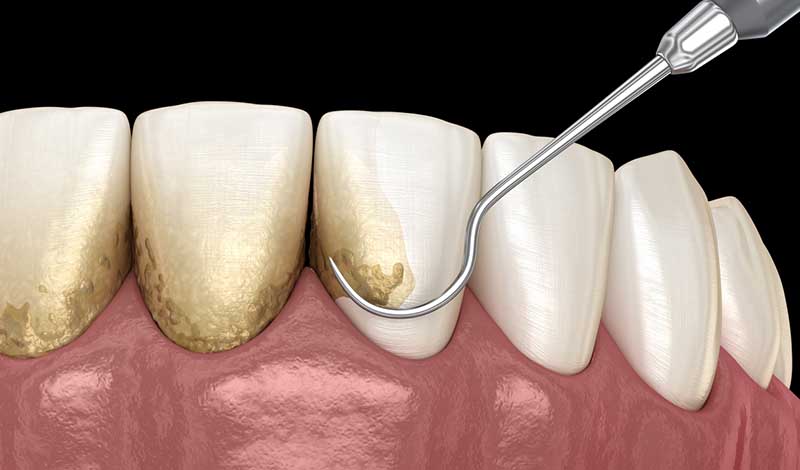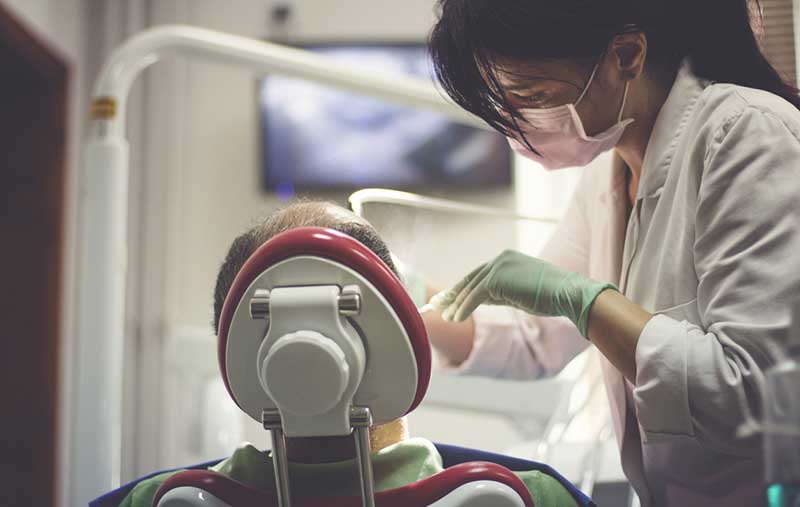
Along with brushing at least twice a day and flossing daily, it’s recommended that you have bi-annual dental cleanings done by a licensed hygienist. It is the hygienist’s job to clean your teeth using specialized tools and techniques. While many people assume that the cleaning you’d get at a dental office is similar to what you’d do at home, it is much different and can help in preventing tooth decay and gum disease.
The hygienist is trained to carefully and effectively remove built-up calculus (hardened plaque), tartar, and even stains. By taking a proactive approach to your dental care and understanding the need for regular cleanings, you can both prevent and treat gum disease.
Only Professional Dental Cleaning Tools Remove Disease-Causing Calculus and Tartar
When you brush your teeth at home, even if you’re using the best-quality electric toothbrush, there will still be plaque left behind. Over several months, this plaque hardens on certain areas of the teeth, causing thick white patches that aren’t just problematic to the look of your smile but can also be just as harmful to the health of your gums. This hardened plaque, known as calculus, is impossible to remove on your own with brushing and flossing alone. Only professional dental tools can remove hardened plaque as well as tartar from the teeth. If left untreated, this bacteria-laden calculus infects the gum tissue, causing gingivitis and eventually gum disease.
Your hygienist will use special tools called scalers to scrape away the calculus and tartar from the teeth. This exposes underlying gum tissue so that when you brush and floss at home, you’re able to reach these areas that were once covered and hidden under a layer of hardened plaque. If it’s been a while since your last dental cleaning, take a look in the mirror and you may notice these white patches on different areas of your teeth. Fortunately, no matter how bad the buildup is on your teeth, it can quickly be removed with professional cleaning. Another benefit to removing calculus is that it can get rid of persistent bad breath.
A Cleaner, Healthier Mouth with Bi-Annual Appointments
Your six-month dental cleaning involves both a professional cleaning and a thorough examination. During the dental cleaning, the hygienist works to remove hardened plaque, tartar, and stains from the teeth. The teeth are then polished and flossed to remove any debris or plaque from between teeth.
Along with a thorough cleaning of each tooth, the hygienist will measure your gums. When gingivitis and gum disease is allowed to progress, small gum pockets develop around the teeth. These gum pockets eventually get larger as the disease progresses, allowing plaque, bacteria, and debris to become lodged between the gum tissue and the tooth. This further infects the gums, eventually leading to tooth and bone loss.
Measuring the gum pockets is easy, painless, safe, and takes absolutely no time in-office. If pockets are over 3mm in-depth, this could be a sign that there is gingivitis or gum disease present. Fortunately, early detection of gingivitis can help to reverse the inflammation before it is allowed to progress to gum disease. For patients who already have undiagnosed gum disease, measuring the gum pockets can help in creating a personalized treatment plan to save their teeth and improve the health of their gums.
Gum Disease Can Be Detected in Its Early Stages
By making a habit of going in for your twice-yearly dental checkups, you’re keeping up with the health of your teeth and gums. When your hygienist checks your gums for signs gum disease, they’ll be able to detect it in its early stages. Gum disease is much easier to treat when it’s in its early stages, and gingivitis is completely reversible.
If you suspect that you might have gum disease because your gums feel irritated, inflamed, and bleed when you brush or floss, it’s time to go in for a dental checkup. Taking an active approach to your dental health starts with regular dental checkups and professional dental cleanings.
Sound, Professional Oral Hygiene Advice
If you walk down the oral healthcare aisle at your local supermarket or big box store, it can be confusing to know which products are right for you and which ones to use regularly. When you visit your hygienist for a cleaning, they will be able to give you product recommendations and advice to better your oral health.
If you already have gingivitis or gum disease, these recommendations are provided to you to prevent the spread of the infection and underlying disease. To prevent gum disease from developing, proper oral hygiene should be followed at home on a daily basis. Some of the recommendations your hygienist will provide include:
The best toothbrush to use
The right toothpaste for your oral health needs
Flossing products
Education on how to brush and floss properly
Mouthwash recommendations
Prescription-strength dental products
Professional Dental Cleanings are For More Than Teeth
Not only will a dental checkup look for signs of tooth decay and loose restorations, but your bi-annual appointments are crucial for detecting signs of gingivitis, gum disease, and for keeping your teeth and mouth clean. Gum health is a direct correlation to the health of your smile. When your gums are inflamed and infected, this can eventually cause issues with your teeth. In fact, gum disease is the number one cause of tooth loss, and it’s been estimated that 70-80% percent of adults have gum disease. While incredibly common, gum disease can be prevented entirely so that it doesn’t eventually lead to tooth and bone loss.
Your best line of defense in keeping your teeth and gums healthy is with a bi-annual dental checkup. Your twice-a-year appointment involves a thorough cleaning performed by a licensed hygienist who will clean your teeth and check your gums for signs of infection. The exam is just as important, as it helps in creating a treatment plan that is right for your oral health needs. If you already have gingivitis or gum disease, keeping up with regular dental checkups is essential in preventing the progression of the disease.


